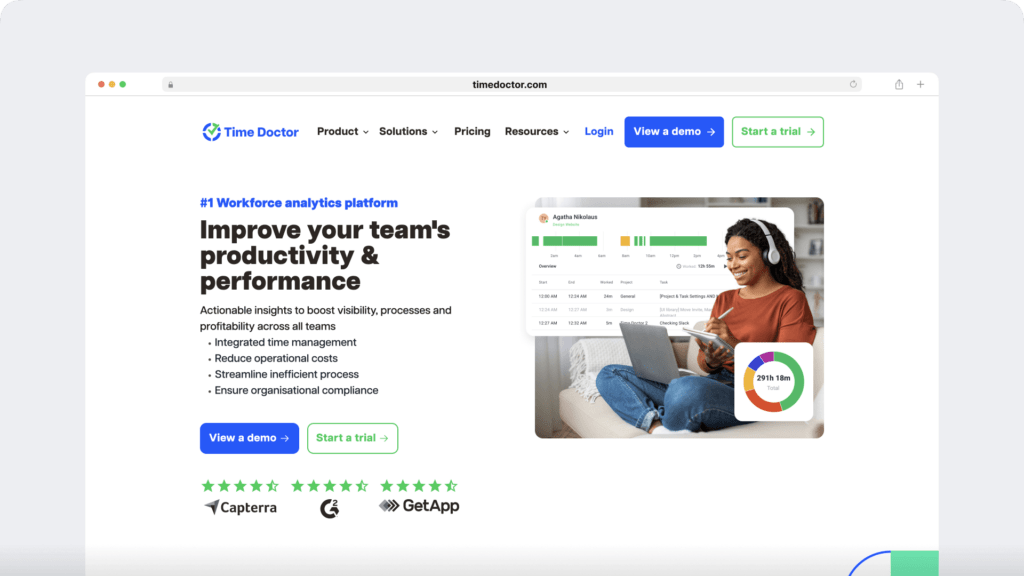Why are you paying full-time salaries for tasks an expert outsider could handle better, for half the cost?
You spent $50,000 last month on payroll.
However, nearly 40% of that went to non-core tasks such as administration, IT support, and basic data entry.
That’s $20,000 lost on work your team didn’t need to manage using internal resources.
Now imagine if a specialized outsourcing company handled it, which would be more efficient, at a lower cost, and with better results.
That’s the power of strategic outsourcing.
You can entrust some business operations to third-party companies with proven experience, unlocking the benefits of strategic outsourcing, cost reduction, time management, and improved operational efficiency.
This outsourcing strategy has gained serious traction in recent years. It’s estimated that 300,000 positions are outsourced every year.
The gig economy is booming, and an increasing number of businesses are leveraging latest technologies and outsourcing services to streamline their operations and stay competitive.
According to various studies, strategic outsourcing can help companies reduce operational costs by up to 35% and increase return on equity by 6%, all while accelerating revenue growth.
And this isn’t just theory. According to the Industry Week Census on Manufacturing, 54.9% of U.S. companies outsource manufacturing, and 43.8% outsource equipment maintenance.
While you’re overstaffing and overstretching, your competitors are focusing on their core competencies, saving money, and scaling faster.
So ask yourself:
How much are you losing by trying to do it all in-house?
In this article, we’ll break down what strategic outsourcing means, where it started, the different types of outsourcing services available today, and why it’s one of the most powerful tools for cost savings and competitive advantage.
You’ll also discover the key benefits of outsourcing, potential risks to watch for, and how successful companies use this approach to optimize processes, reduce waste, and focus on what they do best.
Table of contents
- What is strategic outsourcing?
- How did strategic outsourcing begin?
- 6 common types of strategic outsourcing (with real-world use cases)
- What are the advantages of strategic outsourcing?
- What are the disadvantages of strategic outsourcing?
- When should you use strategic outsourcing?
- How Time Doctor makes outsourcing easier
What is strategic outsourcing?
Strategic outsourcing is a long-term partnership between a company and an external service provider. Instead of asking your internal team to handle everything, you pass specific tasks, often non-core functions, to experts outside your organization.
It’s like running a bakery in New York and purchasing your packaging from a supplier in Vietnam, rather than adding packaging to your internal production process.
The overseas partner specializes in packaging, operates at scale, and delivers higher quality at a lower cost.
You don’t just save time; you can focus more on baking while your partner helps you achieve business goals.
This goes beyond regular outsourcing.
Successful outsourcing means sharing responsibility for results and outcomes that align with your business goals.
Your outsourcing provider doesn’t just provide a service; they help you reach targets tied to performance, efficiency, or growth.
You can outsource a single process, a group of tasks, or a whole department. It’s commonly done for IT services, finance, customer support, social media, and other business process outsourcing (BPO) areas.
The goal is simple: reduce operational costs and free up your internal team to focus on core competencies.
Your team focuses on core business functions they do best, while specialists elsewhere handle the rest, creating a strategic advantage in time and performance.
A 2023 study titled Strategic Outsourcing and Firm Performance: A Review of Literature confirms this. It found that companies that outsource strategically gain access to specialized talent, improve responsiveness, and often see measurable gains in financial performance.
Why strategic outsourcing works
It’s not just about cutting costs. Strategic outsourcing lets you:
- Optimize operations without hiring more people
- Use external human resources more efficiently
- Free up your internal team to focus on growth while external resources handle non-core tasks
- Get better outcomes through expert support
Unlike hiring temporary staff, your outsourcing partner is fully accountable for their work. They manage the tools, the team, and the final results.
What to outsource—and when
To maximize the benefits of outsourcing, begin by evaluating your internal resources. Ask:
- Which tasks drain time but don’t grow the business?
- What work requires specialized skills you don’t have in-house?
As Michael Porter’s five strategic pillars suggest, your outsourcing decisions should support:
- The competitiveness of your products or services
- Your brand image
- The ability to respond quickly to sales opportunities
- Your technical capacity
- Your overall financial health
If outsourcing helps you move faster, improve risk management, and boost output, it’s probably the right move.
How did strategic outsourcing begin?
Strategic outsourcing may sound modern, but the concept has been around for over a century.
In the 1920s, General Motors was in a fierce race with Ford. At the time, GM’s leader Alfred Sloan made a bold decision and separated the company’s operations into core competencies and non-core tasks.
Instead of doing everything in-house, GM hired external service providers to handle less critical initiatives and functions.
This allowed the company to focus its internal resources on vehicle design and production while outsourcing parts of the supply chain, like components or logistics.
The result? Faster growth, lower operational costs, and better performance.
That was one of the first major examples of what is now known as strategic outsourcing.
From cost-cutting to competitive advantage
In the 1980s and 1990s, companies began to view outsourcing as more than just a means to save money. It became a real outsourcing strategy to streamline operations, reduce waste, and tap into outside expertise.
Businesses began to outsource:
- Human resources
- Cleaning and maintenance
- Logistics and catering
- IT services and admin support
For instance, a white paper by MyOutDesk emphasizes that, by 2025, strategic outsourcing will remain a pivotal strategy for businesses seeking to adapt to shifting market landscapes.
The report highlights how outsourcing enables companies to access specialized expertise, reduce labor costs, and maintain operational flexibility, all while focusing on core competencies.
Additionally, a Forbes article discusses how hybrid outsourcing models are gaining traction in 2025. These models combine local leadership with cost-effective offshore talent pools, allowing businesses to maintain oversight and quality control while benefiting from reduced operational costs.
Furthermore, a report from Global Banking & Finance Review notes that the global outsourcing services market reached $854.6 billion in 2025, reflecting a sustained shift toward more strategic, value-driven engagements.
This growth underscores a broader redefinition of outsourcing, not just as a cost-saving measure but as a lever for transformation and innovation.
These sources collectively indicate that, as of 2025, outsourcing remains a key strategy for businesses to navigate economic pressures, optimize operations, and focus on their core competencies.
6 common types of strategic outsourcing (with real-world use cases)
Businesses employ strategic outsourcing to reduce operational costs, focus on core competencies, and optimize internal resources.
1. Production outsourcing
Many global brands outsource manufacturing to external service providers, enabling them to concentrate on design, marketing, and retail operations.
For instance, IKEA collaborates with over 2,500 suppliers worldwide to produce its products, allowing the company to focus on its core competencies.
2. IT -outsourcing
Services of a certified IT specialist are not cheap, and not every company has enough work for a permanent employee. In such cases, outsourcing proves to be a viable solution for both start-ups and large corporations.
There are two main types of IT outsourcing:
- Maintenance of equipment (computer network servicing and other desk services);
- Software development and network infrastructure creation.
IT outsourcing enables businesses to address the challenge of finding qualified personnel, lower labor costs, save money on equipment purchases, and improve employee time tracking to reduce the cost of software updates.
Alibaba, an international e-commerce company, did not employ permanent software developers. It used the US outsourcing services to launch its platform.
And Cisco, one of the IT giants, outsources its technical support services to India and the Philippines.
3. Business process outsourcing (BPO)
BPO involves contracting out routine operations, such as customer service, payroll, and human resources, to specialized providers.
SaaS companies, for instance, often outsource customer support to ensure 24/7 availability, allowing internal teams to focus on product development.

4. Knowledge process outsourcing (KPO)
KPO entails outsourcing specialized tasks that require expertise, such as financial analysis, legal research, or market intelligence.
Financial firms frequently outsource investment research to firms like SG Analytics, gaining access to in-depth analysis across various asset classes.
5. Financial outsourcing
Businesses often outsource accounting, tax preparation, and financial reporting to external experts, enhancing accuracy and compliance.
E-commerce companies, for example, partner with firms like Howard CPAs to manage complex tax and accounting requirements, allowing them to focus on growth.
6. Recruitment process outsourcing (RPO)
RPO involves transferring all or part of the recruitment process to external service providers, streamlining hiring and improving talent acquisition.
Companies like Globy specialize in building remote-ready teams for high-growth industries, offering scalability and flexibility in recruitment.
Each type of strategic outsourcing enables companies to optimize operations, reduce overhead, and maintain a competitive edge.
By leveraging external expertise, businesses can focus on their core activities and drive sustainable growth.
What are the advantages of strategic outsourcing?
You’re under pressure to do more with less, lower costs, boost profits, and keep your team focused.
But when your staff spends hours on payroll, admin, or IT support, your core business takes a hit.
That’s where strategic outsourcing comes in.
Instead of stretching your team thin, you hand off non-core tasks to skilled partners who do it better and cheaper.
With today’s cloud tools and real-time communication, managing remote teams feels just like in-house.
What used to be a backup plan is now a smart, long-term strategy.
Let’s break down seven real advantages that make strategic outsourcing worth it.
1. Lower operating costs without cutting corners
Strategic outsourcing enables companies to reduce labor and operational costs while maintaining high service quality. Instead of hiring full-time staff for repetitive tasks, businesses partner with BPO providers who handle them more efficiently and effectively.
This approach is not about sacrificing quality. Well-negotiated outsourcing contracts enable you to utilize your budget more effectively and invest where it truly matters.
2. Focus on core competencies, not busywork
When your internal team isn’t tied up with administrative tasks, customer support, or payroll, they can focus their energy on areas that directly drive business growth.
Strategic outsourcing clears the way, allowing your top talent to focus on building products, serving customers, and refining strategy.
3. Faster access to high-level skills
You don’t have to wait months to find and train niche experts. Outsourcing provides you with immediate access to professionals who possess the experience, tools, and certifications your team requires.
This means faster execution, especially in areas such as IT, finance, or compliance, where specialized knowledge is crucial.
4. Better workflow management and flexibility
Outsourcing partners often use structured systems with KPIs to manage work consistently. You gain more reliable timelines, better quality control, and the ability to scale up or down as your business needs change.
Achieving this level of flexibility can be challenging with only in-house teams.
5. 24/7 operations and faster turnaround
When you work with providers in different time zones, your business can stay productive even after your local team finishes for the day.
This results in round-the-clock progress, which is especially helpful for customer service, tech support, or digital content production.
6. Shared goals and performance accountability
In strategic outsourcing, service providers go beyond simply delivering tasks. They commit to your success. Your KPIs become their benchmarks, from customer satisfaction to cost savings or faster delivery.
Understanding the roles: in-house teams, outsourcing partners, and freelancers
- Internal teams focus on your core competencies, the strategic work that drives growth and defines your brand.
- Outsourcing partners assume responsibility for non-core functions, such as IT support, payroll, or customer service. What sets them apart is their long-term commitment to delivering measurable outcomes, not just completing tasks.
- Freelancers bring agility and niche expertise. They’re ideal for short-term projects or specialized roles, often working independently without being tied to broader business objectives.
All three play a role. But strategic outsourcing focuses on performance-driven partnerships with providers who align with your objectives, not just execute tasks.
7. Stronger business continuity
Strategic outsourcing provides your company with greater stability. Whether you’re facing staff shortages, market changes, or unexpected disruptions, outsourcing teams can keep operations running smoothly without interruption.
This kind of support helps you maintain momentum and stay ready for whatever comes next.
Now that you’ve seen the upsides, it’s easy to understand why strategic outsourcing is gaining traction across industries.
But like any long-term business strategy, it’s not without risks.
Before you dive in, it’s just as important to understand what can go wrong—and how to avoid those common pitfalls.
Let’s explore the disadvantages of strategic outsourcing and what they really mean for your business.
What are the disadvantages of strategic outsourcing?
When done right, outsourcing can drive real value. When rushed or mismanaged, it can create setbacks that do more harm than good.
Before jumping in, you need to understand the trade-offs.
Let’s examine the most common disadvantages of strategic outsourcing and how to prepare for them.
1. Less control over daily operations
When you outsource, you trust an external service provider to handle part of your business. While this reduces the workload, it also means you no longer have direct oversight of how tasks are completed.
This can become tricky if the outsourcing relationship isn’t aligned and the provider’s standards or pace differ from your internal expectations.
You might face delays, inconsistent communication, or quality issues if there’s a mismatch.
That’s why it’s essential to establish clear performance metrics, communication protocols, and service-level agreements from the outset.
2. Data privacy and security risks
Outsourcing often involves sharing sensitive data, such as customer information, business insights, and internal workflows, with third-party vendors.
Without the proper security measures, you open the door to data leaks, cyberattacks, or misuse of private information.
Choosing outsourcing partners with strict data protection protocols and compliance certifications is non-negotiable.
Ensure they align with your internal IT policies and legal requirements, particularly in industries such as finance or healthcare.
3. Hidden or rising costs
Outsourcing can lower operational costs, but unexpected fees and scope creep can turn the equation around. Some providers charge extra for revisions, speed, or additional services that weren’t part of the original deal.
To avoid budget blowouts, outline pricing structures in detail and ask for transparent billing. Using workforce analytics tools can help track hours, project scope, and performance in real-time.
4. Risk of vendor dependency
When a service provider becomes the only one who knows how your outsourced process works, you face vendor lock-in. If they underperform or raise prices, switching becomes painful and costly.
Avoid this by documenting workflows, maintaining backups of training materials and assets, and retaining some level of in-house knowledge. This protects your flexibility and future options.
5. Misalignment with your brand or culture
An external partner won’t know your company values and customer experience the way your internal team does. If your brand voice, tone, or workflow is unique, outsourcing could create friction or inconsistency.
To minimize this, onboard your providers the same way you do new employees. Share brand guidelines, customer policies, and examples. Regular check-ins also help bridge any gaps in understanding.
When should you use strategic outsourcing?
Strategic outsourcing is most effective when you require flexibility, cost savings, and access to specialized talent. Here are the most common situations where it makes sense:
1. Your business is growing quickly
You need to scale, but hiring takes time. Outsourcing helps you meet demand without overloading your internal team.
2. You lack specific skills in-house
For tasks like IT infrastructure, technical support, or digital marketing, it’s faster and wiser to bring in external experts.
3. Your team is stuck doing non-core work
If admin, payroll, or customer service tasks consume time, outsourcing these processes allows your employees to focus on what drives growth.
4. You want to reduce fixed costs
Full-time hires mean salaries, benefits, and office space. Outsourcing replaces those with task-based pricing and lowers overall spend.
5. You manage a remote or hybrid team
Outsourcing supports digital transformation by helping you cover more time zones, extend support hours, and stay agile across a distributed workforce.
6. You need better visibility and tracking
With the right productivity analytics and employee monitoring, you can track outsourced performance just as closely as your in-house team.
How Time Doctor makes outsourcing easier

Outsourcing only delivers results when you have full visibility into performance, timelines, and output. Time Doctor gives you the tools to manage distributed teams, monitor productivity analytics, and improve accountability. This applies whether you’re outsourcing locally or internationally.
With Time Doctor, you can:
a. Assign and track time by task, project, or client
Strategic outsourcing only works if you know how your team’s time is spent. Time Doctor provides real-time data on task-level time tracking. This helps you measure output across contractors and internal teams. You can track hours for billable projects and manage multiple outsourcing partners more easily.
b. Monitor screen activity without micromanaging
Screen monitoring provides a balanced approach to ensuring focus while respecting privacy. You can review screenshots or activity levels to confirm work quality. This is especially useful for outsourced functions such as data entry, technical support, or software development.
c. Gain workforce analytics across remote, hybrid, and in-office setups
Time Doctor provides visibility across all work settings. Whether your outsourcing partner is offshore or based locally, you can compare productivity levels across your entire distributed workforce. This includes analytics on idle time, active hours, and workflow trends.
d. Automate payroll based on tracked hours
Managing payroll becomes more complex with global outsourcing. Time Doctor automatically calculates pay based on timesheets, helping you reduce errors and minimize manual work. It also supports multiple currencies, which simplifies payments for freelancers and BPO providers.
e. Get attendance and shift reports in one place
You can track when team members, whether internal or outsourced, begin and end their workdays. Attendance reports help you evaluate outsourcing partners fairly and maintain consistent standards across your workforce.
f. Spot outliers using unusual activity reports
Outsourced teams often work independently. Time Doctor highlights low activity levels or unexpected patterns, which allows you to address issues quickly and maintain high performance.
g. Use productivity ratings to assess performance
Time Doctor allows you to rate websites and apps as productive, unproductive, or neutral. This provides you with deeper insights into how your outsourced team allocates their time, helping you identify opportunities for improvement.
h. Integrate with your favorite project management and communication tools
Time Doctor features include integrations with over 60 apps, including Asana, Trello, Slack, and Jira. These integrations ensure your outsourcing partners stay aligned with your internal processes and team communications.
i. Access real-time reports from a central dashboard
You can see how every contractor or service provider is performing using a single dashboard. You can also filter by team, client, project, or date range to analyze performance and make better outsourcing decisions.
Discover how to cut costs, boost output, and stay entirely in control. Get a demo of Time Doctor.

Liam Martin is a serial entrepreneur, co-founder of Time Doctor, Staff.com, and the Running Remote Conference, and author of the Wall Street Journal bestseller, “Running Remote.” He advocates for remote work and helps businesses optimize their remote teams.


